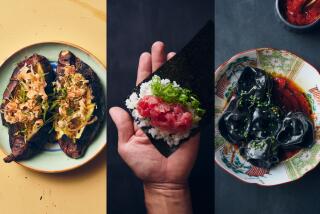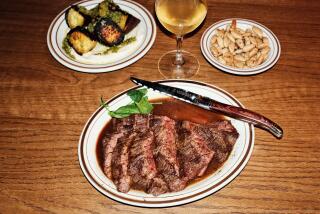RESTAURANT REVIEW : Eat to the Beat : The good Japanese fare at Karaoke shares the bill with patrons hungry to have their way with a song.
- Share via
They won’t pay you to sing at Karaoke (pronounce it “kahrah-okay,” rather than “carrie-okie,” if you want to impress a Japanese friend). But at one buck a song, it won’t cost you much, either.
I refer, of course, both to a restaurant called Karaoke and to karaoke, that now-institutionalized form of singing along to a laser disc recording of a favorite popular song, complete with inane video, glorious orchestral accompaniment and a bouncing hand (as opposed to a bouncing ball) to help you follow the lyrics.
Karaoke, literally “empty orchestra” in Japanese, is more popular than ever today in its country of origin. A slow economy has made karaoke a preferred format for office parties in Japan--and here, too, truth be told--though over there, they’re usually held in rented hotel rooms, as opposed to restaurants.
Lucky us. We can go to the brand-new Karaoke restaurant in Sherman Oaks, croon on the cheap and get a good Japanese dinner to boot.
If Karaoke looks strangely familiar, that’s because this location was once the upscale French restaurant Camille’s. The walls are still pinkku (pink)-- pinkku stucco, to be exact--and there’s lots of etched glass and a tapestry ceiling to disorient a first-time visitor.
Owners Yoshi and Kathy Iwakiri have removed several of the old booths, the better to cater to the Japanese aesthetic of spareness, but I dare say there isn’t a karaoke establishment anywhere with more fin-de-siecle elegance.
Here’s the setup. You peruse a huge songbook broken down by decades (the ‘70s, the ‘80s, etc.). Then you tell Kathy or one of her waitresses which song you want to sing, and you get up on the stage and make a spectacle of yourself.
I’m not recommending that you loosen up with one of the restaurant’s bizarre sake martinis (heavy on the dry vermouth) or a liter bottle of a clean-tasting, high-quality Japanese beer called Sapporo Ginjikomi, but that’s exactly what a great many of the Iwakiris’ customers do. Personally, I sang “Fools Rush In” clean and sober. It seemed an appropriate choice.
Of course, you don’t have to sing on an empty stomach.
You’ll start with a complimentary otsumame , little rice crackers that cost you an arm and a leg at bars in Japan, and even a free zensai (appetizer) that might be something like shredded gobo (burdock root) lightly dressed with white sesame seeds and sesame oil. It’s delicious.
The best appetizer on the menu is probably yudofu , which consists of large, fluffy squares of bean curd served in steaming broth with Napa cabbage leaves. Oden , not on the menu, is the quintessentially weird Japanese yatai (food-stall dish). It’s between a soup and a stew, the broth in this case being no more than a forum for oddly shaped fish cakes, carved globes of giant radish, odd bits of root vegetables (carrot, maybe even more burdock) and anything else the chef wants to throw in.
Chef Yoshi’s shrimp and vegetable tempura is properly crisp and light, best eaten immediately and not, as the Japanese often serve it, after it has cooled. It comes with a deeply burnished soy dipping sauce. Ask for oroshi (grated radish) and they’ll bring it. Dissolve the oroshi in your dipping sauce and the tempura will take on an added dimension.
So much for the appetizers. Now for the entrees, which can be ordered a la carte or as part of a full dinner.
The latter option adds a miso soup, sunonmono (a vinegared course that might be something like sliced cucumbers with octopus), rice, tea and, at the end, a choice of ice creams: green tea or red bean flavor.
You might choose either shabu-shabu or sukiyaki for your entree. These dishes contain pretty much the same ingredients and are both cooked at the table on little one-burner gas ranges. Sukiyaki is the one I prefer because everything is cooked together as opposed to sequentially, which is the shabu-shabu way. It’s composed of thick noodles, razor-thin slices of high-quality beef, Napa cabbage, onion, daikon radish and a few other ingredients, together in a pot of full-flavored sauce.
If that sounds too bothersome, try something simpler like broiled salmon with teriyaki sauce (salmon being the proper foil for teriyaki) or Yoshi’s fine sashimi combination, featuring yellowtail, tuna and whatever else is fresh. Or you could even have a New York steak served medium rare and cooked with reverence.
Dishes to avoid are the tough tonkatsu (pork cutlet) and the curry rice, a glutinous bowl of sauced rice.
To love these, you’ve got to be Japanese, or a starving karaoke artist.
Where and When Location: Karaoke, 13573 Ventura Blvd., Sherman Oaks. Suggested dishes: yudofu , $3.50; tempura mix, $7.50; broiled salmon, $14.90 ($12.90 a la carte); sukiyaki, $18.90 ($16.90 a la carte). Hours: Dinner nightly 6 p.m. to 2 a.m. Price: Dinner for two, $25 to $35. Karaoke, $1 a song. Beer and wine only. Limited parking in side lot. MasterCard and Visa accepted. Call: (818) 995-1660.
More to Read
Eat your way across L.A.
Get our weekly Tasting Notes newsletter for reviews, news and more.
You may occasionally receive promotional content from the Los Angeles Times.










